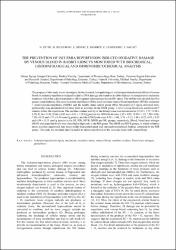| dc.contributor.author | Çetin, Nihal | |
| dc.contributor.author | Süleyman, Halis | |
| dc.contributor.author | Şener, Ebru | |
| dc.contributor.author | Demirci, Elif | |
| dc.contributor.author | Gündoğdu, Cemal | |
| dc.contributor.author | Akçay, Fatih | |
| dc.date.accessioned | 2020-12-19T20:03:11Z | |
| dc.date.available | 2020-12-19T20:03:11Z | |
| dc.date.issued | 2014 | |
| dc.identifier.citation | Cetin, N., Suleyman, H., Sener, E., Demirci, E., Gundogdu, C., Akcay, F. (2014). The prevention of ischemia/reperfusion induced oxidative damage by venous blood in rabbit kidneys monitored with biochemical, histopatological and immunohistochemical analysis. Journal of Physiology and Pharmacology, 65(3), 383-392. | en_US |
| dc.identifier.issn | 0867-5910 | |
| dc.identifier.uri | https://hdl.handle.net/11436/3111 | |
| dc.description | Cetin, Nihal/0000-0003-3233-8009; Gundogdu, Cemal/0000-0003-2857-923X | en_US |
| dc.description | WOS: 000338408900007 | en_US |
| dc.description | PubMed: 24930510 | en_US |
| dc.description.abstract | The purpose of this study was to investigate the biochemical, histopathological and immunohistochemical effects of venous blood on ischemia/reperfusion-induced oxidative DNA damage and mutation in rabbit kidneys in comparison to melatonin treatment, which has a known protective effect against ischemia/reperfusion (IR) injury. the rabbits were divided into five groups: renal ischemia (RI), renal ischemia-reperfusion (RIR), renal ischemia-venous blood-reperfusion (RIVR), melatonin + renal ischemia-reperfusion (MRIR), and the healthy sham control group (HG). Melatonin (2.5 mg/kg delivered intraperitoneally) was administered one hour prior to ischemia. in the RIVR group, 1 ml of venous blood was administered 5 minutes before the reperfusion. the xanthine oxidase activity in the kidney tissue was determined as 53.50 +/- 1.72, 31.00 +/- 6.39, 45.66 +/- 9.20, 28.66 +/- 6.05 and 14.33 +/- 1.28 U/g protein; the MDA levels were 6.32 +/- 0.02, 19.50 +/- 1.33, 7.00 +/- 0.96, 7.50 +/- 0.76 and 4.75 +/- 0.34 mmol/g protein; and the GSH levels were 4.50 +/- 1.08, 2.76 +/- 0.13, 5.48 +/- 0.22, 4.93 +/- 0.55 and 6.98 +/- 0.33 nmol/g protein in the RI, RIR, RIVR, MRIR and HG groups, respectively. Blood, blood urea nitrogen (BUN) and creatinine levels were classified as high only in the RIR group. the MRIR and RIVR groups, in which oxidative stress was best suppressed, had much milder histopathological and immunohistochemical findings compared to the RIR. group. This study has revealed that it is useful to initiate reperfusion of the ischemic tissue with venous blood. | en_US |
| dc.language.iso | eng | en_US |
| dc.publisher | Polish Physiological Soc | en_US |
| dc.rights | info:eu-repo/semantics/openAccess | en_US |
| dc.subject | Ischemia/reperfusion injury | en_US |
| dc.subject | Melatonin | en_US |
| dc.subject | Oxidative stress | en_US |
| dc.subject | Venous blood | en_US |
| dc.subject | Xanthine oxidase | en_US |
| dc.subject | Blood urea nitrogen | en_US |
| dc.subject | Glutathione | en_US |
| dc.title | The prevention of ischemia/reperfusion induced oxidative damage by venous blood in rabbit kidneys monitored with biochemical, histopatological and immunohistochemical analysis | en_US |
| dc.type | article | en_US |
| dc.contributor.department | RTEÜ, Tıp Fakültesi, Dahili Tıp Bilimleri Bölümü | en_US |
| dc.contributor.institutionauthor | Çetin, Nihal | |
| dc.contributor.institutionauthor | Süleyman, Halis | |
| dc.identifier.volume | 65 | en_US |
| dc.identifier.issue | 3 | en_US |
| dc.identifier.startpage | 383 | en_US |
| dc.identifier.endpage | 392 | en_US |
| dc.relation.journal | Journal of Physiology and Pharmacology | en_US |
| dc.relation.publicationcategory | Makale - Uluslararası Hakemli Dergi - Kurum Öğretim Elemanı | en_US |


















